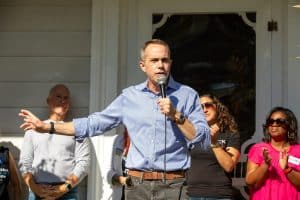Consider the situation of Charles—a young Black man who showed up at HOPE 4 Youth, a drop-in center for youth facing homelessness in suburban Minneapolis. His grandmother, who he was staying with, had given him until the end of the month to find a new place. His name wasn’t on the lease and the stress of their under-the-radar arrangement had become too much for her.
Options for young people in Charles’ situation, who don’t have a rental history and don’t make enough to realistically afford their own place, are limited. He could do an intake through the local “coordinated entry” system, part of the federally-funded triage process that acts as a gateway to homelessness resources.
But because Charles wasn’t actually homeless, he would not end up among the 35 percent of young people who were deemed most in need by the coordinated entry system and thus eligible for housing. Even those who do make the cut routinely wait months until they can move into housing.
Our current response to youth facing homelessness—generally defined as unaccompanied minors and young adults, sometimes with their own children—is clearly unable to meet the burgeoning need. We need to try something new, but what?
In its expansive new research agenda, the U.S. Interagency Council on Homelessness (USICH) asks in regard to youth homelessness: “What actions can affirm chosen family and stabilize informal hosting?”
In other words, amidst a dire affordable housing crisis, rather than trying to find housing for youth, why not investigate how we can empower the family friends, neighbors and extended family who are already stepping up to host young people who they know and care about?
We need to look especially closely at the barriers faced by hosts who, like Charles’ grandmother, are renters. Obstacles to providing stable hospitality can include lease restrictions on how long guests can stay or stipulations on housing benefit programs that can make adding another person to the household onerous.
The unconscionable overrepresentation of young people of color—Black youth are 83 percent more likely and Hispanic youth are 33 percent more likely to face homelessness than youth of other races—is almost certainly linked to the fact that, due to racist practices such as redlining, the majority of Black and Hispanic households in the U.S. rent, unlike the majority of white households.
READ: The Way We Treat Our Unhoused Neighbors Is Criminal
That means that, unlike most white youth, most Black and Hispanic youth grow up in renter households, which are more financially vulnerable than homeowner households. Then, given our segregated society, if a Black or Hispanic young person is in crisis and needs a place to stay, the people they first turn to for help most likely also share their same race. Thus, they are also likely renters who are less able to offer the kind of dependable hospitality that could forestall unsheltered homelessness.
Fortunately for Charles, the case manager he met with at the drop-in center, Brenda Pritchard, was experienced in supporting chosen family hosting arrangements. Given that Charles’ unauthorized residency was the real impediment, Brenda offered to help his grandmother talk with the property owner.
Through a philanthropically-funded pilot program, Brenda was able to offer a monthly stipend that could be paid directly to the property owner and, even more significantly, Brenda could share her phone number. That gave the property owner welcome reassurance: She wouldn’t have to troubleshoot any issues that arose on her own. She could call Brenda.
That USICH is calling for further investigation of this approach, which helped Charles continue staying with his grandmother, is game-changing. While we desperately need more affordable housing, we will not be able to build our way out of the population-level crisis that youth homelessness has become.
We need to take concrete steps if we are to reduce the unconscionable racial disparities in youth homelessness. The recent Strengthening the Village project from Chapin Hall at the University of Chicago can act as a helpful starting point: A research overview, policy recommendations and practice suggestions explore how to bolster informal hosting arrangements, with special attention given to renters hosting youth who would otherwise be homeless.
READ: Starve or Quit: Some College Students’ Only Options
We owe it to the one in ten young adults who face homelessness every year to accept USICH’s invitation and explore how to fortify chosen family hosting, especially in underestimated and under-resourced communities.
This column was produced for Progressive Perspectives, a project of The Progressive magazine, and distributed by Tribune News Service.






